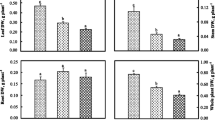Summary
In pot experiments grape vine was grown on a calcareous and on a non calcareous soil with a low and with a high water saturation. During the growing period soil solution samples were collected and analyzed for their pH and for HCO −3 , phosphate, Fe, and Ca. High water saturation resulted in a pH increase and in an increase of the HCO −3 concentration in both soils. The level in pH and HCO −3 , however, was much higher in the calcareous soil than in the non calcareous soil. The Fe concentration varied much throughout the experimental period, but there was no major differences between soils and water saturation treatments. The Ca concentration of the soil solution increased with time in the calcareous soil; for the non calcareous soil rather the reverse was true. The phosphate level in the soil solution of the non calcareous soil was about 10 times higher than in the calcareous soil.
After 3 weeks growth all plants of the calcareous soil with the high water saturation showed first symptoms of Fe deficiency. These became more intense from day to day. Plants of the other treatments did not show any chlorotic symptoms. In the treatment with the chlorotic plants the HCO −3 concentration of the soil solution was the highest, the phosphate concentration the lowest from all treatments. It is therefore concluded that HCO −3 and not phosphate is the primary cause for lime induced Fe chlorosis. Despite the low phosphate concentration in the soil solution, the P concentration in the chlorotic leaves was more than twice as high as the P concentration in green leaves grown on the same soil. It is thus assumed that the high P content frequently found in chlorotic leaves is the result and not the cause for Fe chlorosis.
Similar content being viewed by others
References
Booss A Kolesch H and Höfner W 1982 Chlorose-Ursachen bei Reben (Vitis vinifera L.) am natürlichen Standort. Z. Pflanzenernähr. Bodenk. 145, 246–260.
Boxma R 1972 Bicarbonate as the most important soil factor in lime-induced chlorosis in the Netherlands. Plant and Soil 37, 233–243.
Brown J C 1960 An evaluation of bicarbonate induced iron chlorosis. Soil Sci. 89, 246.
Carter M R 1980 Association of cation and organic anion accumulation with iron chlorosis of scots pine on prairie soils. Plant and Soil 56, 293–300.
Chen Y and Barak P 1982 Iron nutrition of plants in calcareous soils. Adv. Agron. 35, 217–240.
DeKock P C 1955 Iron nutrition of plants at high pH. Soil Sci. 79, 167–175.
Hai T van and Laudelout H 1966 L'absorption des phosphates par les racines de riz. Ann. Physiol. vég. 8, 13–24.
Jacobson L 1945 Iron in the leaves and chloroplasts of some plants in relation to their chlorophyll content. Plant Physiol. 20, 233–245.
Kovanci I, Hakerlerler H and Höfner W 1978 Ursachen der Chlorosen an Mandarinen (Citrus reticulata blanco) der ägäischen Region. Plant and Soil 50, 193–205.
Lindsay W L 1974 Role of chelation in micronutrient availability.In The Plant Root and its Environment. Ed. E W Carson, pp. 507–524.
Lindsay W L and Norvell W A 1978 Development of a DTPA test for zinc, iron, manganese and copper. Soil Sci. Soc. Am. J. 42, 421–428.
Marschner H 1978 Ernährungs- und ertragsphysiologische Aspekte der Pflanzenernährung. Angew. Bot. 52, 71–87.
Marschner H and Schropp A 1977 Vergleichende Untersuchungen über die Empfindlichkeit von 6 Unterlagensorten der Weinrebe gegenüber Phosphat-induziertem. Zink-Mangel. Vitis 16, 79–88.
Mengel K and Bübl W 1983 Verteilung von Eisen in Blättern von Weinreben mit HCO 3/− induzierter Fe-Chlorose. Z. Pflanzenernähr. Bodenk. 146, 560–571.
Mengel K and Malissiovas N 1981 Bicarbonat als auslösender Faktor der Eisenchlorose bei der Weinrebe (Vitis vinifera). Vitis 20, 235–243.
Mengel K Scherer H W and Malissiovas N 1979 Die Chlorose aus der Sicht der Bodenchemie und Rebenernährung. Mitt. Klosterneuburg (Austria) 29, 151–156.
Müllner L 1979 Ergebnisse eines Chloroseforschungsprojektes. Mitt. Klosterneuburg (Austria) 29, 141–150.
Rutland R B and Bukovac M J 1971 The effect of Calcium bicarbonate on iron absorption and distribution byChrysanthemum morifolium (Ram.) Plant and Soil 35, 225–236.
Schüller H 1969 Die CAL-Methode, eine neue Methode zur Bestimmung des pflanzenverfügbaren Phosphates in Böden. Z. Pflanzenernühr. Bodenk. 123, 48–63.
Author information
Authors and Affiliations
Rights and permissions
About this article
Cite this article
Mengel, K., Breininger, M.T. & Bübl, W. Bicarbonate, the most important factor inducing iron chlorosis in vine grapes on calcareous soil. Plant Soil 81, 333–344 (1984). https://doi.org/10.1007/BF02323048
Received:
Revised:
Issue Date:
DOI: https://doi.org/10.1007/BF02323048




